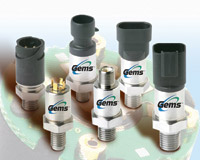
Posted to News on 5th Sep 2011, 00:00
Superior sensors
The quality and range of pressure sensors available is continuing to increase, thanks to highly effective construction technology and a potent package of electronics, says Mike Powers, product marketing director for Gems Sensors and Controls.

The proven capacity of pressure transducers to improve engineering efficiency has driven the designers and engineers of these devices to offer ever-more efficient and versatile components with not only added functionality but also the resilience to withstand particularly aggressive process conditions. Despite the challenge of designing components that offer precise measurements in no more than a millisecond, manufacturers have succeeded in providing options that can cope with extremes of temperature, mechanical shock and vibration.
This has expanded the market for pressure sensors across a broad range of industries, from off-highway vehicles, which use pressure transducers within load-weighing systems, to offshore wind farms, where the forces at work are so powerful, and maintenance so awkward and expensive, that transducers have offered a much needed method of protecting and optimising systems. To appreciate this achievement and understand how to take advantage of it, we need to look at how pressure transducers work.
A transducer is simply a device that converts one type of energy to another; for example, an electric lamp converts electrical energy into light. A pressure transducer is designed to convert fluid pressure into an electrical output signal. Inside a pressure transducer is a strain gauge sensor which, combined with a sophisticated electronics package, detects movement in a pressure sensitive diaphragm and converts the information into electrical signals.
The testing of these devices has resulted in some impressive statistics, measuring a level of accuracy with almost zero drift over time and an operating life in excess of 100 million cycles. With such impressive levels of performance, pressure sensors have proved invaluable in engineering, particularly in applications where accuracy is vital to plant safety or where equipment is difficult to access. The remarkable level of performance that these components are capable of owes much to the advanced strain gauge technologies of sputtered thin film and chemical vapour deposition.
Chemical vapour deposition
Strain gauge sensors can be effectively manufactured using chemical vapour deposition (CVD) technology, which is capable of producing compact devices that provide high levels of accuracy with excellent hysteresis characteristics. CVD sensors can also be manufactured economically, since they are produced on wafers in large batches, using polysilicon deposited on a stainless steel substrate, with the strain gauge patterns being chemically milled.
The wafer is then divided to produce individual sensor beams, which are laser-welded to a stainless steel summing diaphragm and pressure port before being connected to internal electronics for signal conditioning and amplification. It is this process that enables sensor assemblies to be mass produced in volume and at low unit cost.
Gems Sensors and Controls manufactures a range of highly versatile and resilient transducers using CVD. Its 3300 Series pressure transducers possess a wide range of outputs, electrical connections and pressure ports, with pressure ranges from 1 to 16bar, or 15 to 200psi, and are capable of operating over a temperature range of -40°C to +125°C. They also offer a long operating life with excellent resistance to over pressure, while the high temperature vacuum brazing of the stainless steel components during sensor production offers a strong and corrosion resistant structure with low hysteresis and creep.
Sputtered thin film
Another highly effective technology in the production of transducers is sputtered thin film, a process whereby a solid target material is bombarded by energised particles, causing the material to release atoms. In the production of sensors, these atoms are then deposited onto the sensing structure, forming the thin film. The application of the sputtered thin film layer during the manufacture of pressure transducers results in a sensitive, robust sensor that is suitable for direct contact with almost all liquids, oils and gases.
While these methods of production have opened up opportunities for sensors to be used in many more industries, advances in electronics have also been crucial. The advent of ASICs (application specific integrated circuits) has allowed customers to tune the performance and functionality of each transducer to meet their specific requirements. ASICs have also reduced the unit cost of transducers dramatically; the functionality of units that previously sold for £300 can now be delivered from devices costing £30 or less.
The availability of high performance components at affordable prices has given pressure transducers a strong presence across industries and, as they continue to develop and improve, pressure sensors are likely to exercise a greater level of data acquisition and system control. It pays engineers to investigate the possibilities of pressure transduction technology and enhance their systems with this powerful range of tools that can optimise and protect plant and equipment.








